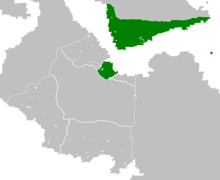Republican Santia: Difference between revisions
(Created page with "{{WIP}} {{Infobox former country |native_name = Venerabile Stato d'Santia |conventional_long_name = Venerable State of Santia |common_name = Republican...") |
mNo edit summary |
||
| Line 139: | Line 139: | ||
[[Category:Liberto-Ancapistan]] | [[Category:Liberto-Ancapistan]] | ||
[[Category:Predecessor states of Liberto-Ancapistan]] | |||
Revision as of 12:48, 6 November 2022
This article is incomplete because it is pending further input from participants, or it is a work-in-progress by one author. Please comment on this article's talk page to share your input, comments and questions. Note: To contribute to this article, you may need to seek help from the author(s) of this page. |
Venerable State of Santia Venerabile Stato d'Santia | |||||||||
|---|---|---|---|---|---|---|---|---|---|
| 1872–1971 | |||||||||
|
Flag of Santia (1852 - 1971) | |||||||||
 The borders of republican Santia (1906 - 1955) | |||||||||
| Status | Republic | ||||||||
| Capital | Orafars | ||||||||
| Common languages | Santian | ||||||||
| Government | Unitary parliamentary republic | ||||||||
| Executive | |||||||||
• 1872 - 1909 | Council of State | ||||||||
• 1909 - 1923 | Gian Pico | ||||||||
• 1923 - 1971 | Council of State | ||||||||
| Legislature | National Assembly of Santia | ||||||||
| History | |||||||||
• Abdication of Ferdinand XII | 5th August 1872 | ||||||||
• Establishment of the Pico Regime | 30th March 1909 | ||||||||
• End of the Pico Regime | 1st September 1923 | ||||||||
• Varisil Accord | 10th January 1955 | ||||||||
• Union with Liberto-Ancapistan | 14th February 1971 | ||||||||
| Currency | Santian Fiat | ||||||||
| |||||||||
Republican Santia, officially known as the Venerable State of Santia (Santian: Venerabile Stato d'Santia) refers to the period in Santian history between the end of the Santian Empire and the union of the country with Liberto-Ancapistan as a province. The early republican period was characterised by the rapid disintegration of the Santian Empire, partly enabled by the Santian government, and the rise of successor states across southern Evrosia. From 1906 to 1955, republican Santia controlled the region of Alta Santia, in addition to the remaining imperial territories of the Varisil Strip, Mherta, and, Giulia VI Land, and became restricted exclusively to Alta Santia from 1955.
Republican Santia was established following the Tricolour Revolution and overthrow of the last Santian Padisa, Ferdinand XII. Initially led by a broad coalition of liberals, radicals and proto-socialists, it helped, both willingly and unwillingly, to accelerate the collapse of the Santian Empire. From the mid-1870s, the radical origins of republican Santia were increasingly displaced by more conservative elements. Republican Santia saw the increasing Industrialisation of Santia, and associated social change. A democratic parliamentary republic, republican Santia had a collective leadership under a Council of State formed from different parliamentary factions, with universal sufferage being in place from 1872 to 1879 and 1926 onwards. Between 1909 and 1923, democracy in Santia was strongly curtailed by the dictatorial Pico Regime under Gian Pico, who seized power in a coup d'état and revived certain imperial themes, before his 1923 assassination. From the mid 1940s, Santian governance was also affected by an increasingly strong military. In the 1950-1955 Great Santian War, Santia attempted to re-occupy parts of Basaquastan, but was decisively defeated, and lost its remaining imperial territories in the Varisil Accord. In the following diplomatic and economic isolation, Santia suffered a protracted period of economic depression and increasing political disunity, the Lost Decade (Alta Santia), before eventually agreeing to join Liberto-Ancapistan as a province with protected autonomies in 1971.
